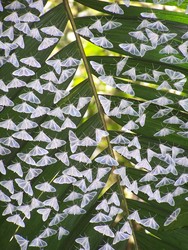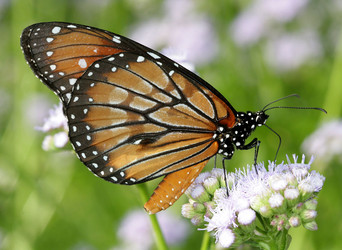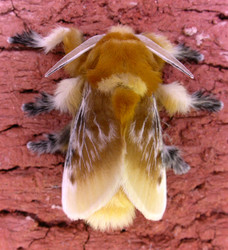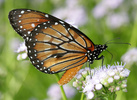Ditrysia



This tree diagram shows the relationships between several groups of organisms.
The root of the current tree connects the organisms featured in this tree to their containing group and the rest of the Tree of Life. The basal branching point in the tree represents the ancestor of the other groups in the tree. This ancestor diversified over time into several descendent subgroups, which are represented as internal nodes and terminal taxa to the right.

You can click on the root to travel down the Tree of Life all the way to the root of all Life, and you can click on the names of descendent subgroups to travel up the Tree of Life all the way to individual species.
For more information on ToL tree formatting, please see Interpreting the Tree or Classification. To learn more about phylogenetic trees, please visit our Phylogenetic Biology pages.
close boxReferences
Boggs, C. L., W. B. Watt, and P. R. Ehrlich, eds. 2003. Butterflies: Ecology and Evolution Taking Flight. University of Chicago Press, Chicago and London.
Dugdale, J. S., N. P. Kristensen, G. S. Robinson, and M. J. Scoble. 1999. The smaller Microlepidoptera-grade superfamilies. Pages 217-232 in: Lepidoptera: Moths and Butterflies. 1. Evolution, Systematics, and Biogeography. Handbook of Zoology Vol. IV, Part 35. N. P. Kristensen, ed. De Gruyter, Berlin and New York.
Fänger, H. 1999. Comparative morphology of tergal phragmata occurring in the thoraco-abdominal junction of ditrysian Lepidoptera (Insecta). Zoomorphology 119:163–183.
Kristensen, N. P. and A. W. Skalski. 1999. Phylogeny and paleontology. Pages 7-25 in: Lepidoptera: Moths and Butterflies. 1. Evolution, Systematics, and Biogeography. Handbook of Zoology Vol. IV, Part 35. N. P. Kristensen, ed. De Gruyter, Berlin and New York.
Minet, J. 1991. Tentative Reconstruction of the ditrysian phylogeny (Lepidiptera, Gloassata). Entomologica Scandinavica 22(1):69-95.
Regier, J. C., Q. Q. Fang, C. Mitter, R. S. Peigler, T. P. Friedlander, and M. A. Solis. 1998. Evolution and phylogenetic utility of the period gene in Lepidoptera. Molecular Biology and Evolution 15(9):1172-1182.
Wahlberg, N., M. F. Braby, A. V. Z. Brower, R. de Jong, M.-M. Lee, S. Nylin, N. E. Pierce, F. A. H. Sperling, R. Vila, A. D. Warren, and E. Zakharov. 2005. Synergistic effects of combining morphological and molecular data in resolving the phylogeny of butterflies and skippers. Proceedings of the Royal Society Series B 272:1577-1586.
Weller, S. J. and D. P. Pashley. 1995. In seach of butterfly origins. Molecular Phylogenetics and Evolution 4(3):235-246.
Title Illustrations

| Scientific Name | Palpita flegia (Cramer, 1777) |
|---|---|
| Location | Santuario de la Mariposa Blanca, Volcán Tacaná, Chiapas (México) |
| Specimen Condition | Live Specimen |
| Identified By | Benigno Gómez |
| Behavior | added in coffee |
| Sex | both sexes |
| Copyright |
© 2009
Benigno Gómez

|
| Scientific Name | Danaus eresimus |
|---|---|
| Location | Bentsen Rio Grande State Park, Texas, USA |
| Specimen Condition | Live Specimen |
| Source | Soldier |
| Source Collection | Flickr |
| Copyright |
© 2006 Patrick Coin

|
| Scientific Name | Megalopyge opercularis |
|---|---|
| Location | Durham County, North Carolina USA |
| Comments | Identified with Covell, Field Guide to the Moths and other sources. Plumose antennae indicate this is a male. See source. |
| Specimen Condition | Live Specimen |
| Identified By | Patrick Coin |
| Behavior | Found at a lighted wall. |
| Sex | Male |
| Life Cycle Stage | adult (imago) |
| View | dorsal |
| Size | circa 30 mm wingspan (estimate) |
| Source | Photo#4905 |
| Source Collection | BugGuide.Net |
| Image Use |
 This media file is licensed under the Creative Commons Attribution-NonCommercial License - Version 2.5. This media file is licensed under the Creative Commons Attribution-NonCommercial License - Version 2.5.
|
| Copyright |
© 2004 Patrick Coin

|
About This Page
Page copyright © 2010
 Page: Tree of Life
Ditrysia.
The TEXT of this page is licensed under the
Creative Commons Attribution-NonCommercial License - Version 3.0. Note that images and other media
featured on this page are each governed by their own license, and they may or may not be available
for reuse. Click on an image or a media link to access the media data window, which provides the
relevant licensing information. For the general terms and conditions of ToL material reuse and
redistribution, please see the Tree of Life Copyright
Policies.
Page: Tree of Life
Ditrysia.
The TEXT of this page is licensed under the
Creative Commons Attribution-NonCommercial License - Version 3.0. Note that images and other media
featured on this page are each governed by their own license, and they may or may not be available
for reuse. Click on an image or a media link to access the media data window, which provides the
relevant licensing information. For the general terms and conditions of ToL material reuse and
redistribution, please see the Tree of Life Copyright
Policies.
- Content changed 17 November 2010
Citing this page:
Tree of Life Web Project. 2010. Ditrysia. Version 17 November 2010 (temporary). http://tolweb.org/Ditrysia/11868/2010.11.17 in The Tree of Life Web Project, http://tolweb.org/











 Go to quick links
Go to quick search
Go to navigation for this section of the ToL site
Go to detailed links for the ToL site
Go to quick links
Go to quick search
Go to navigation for this section of the ToL site
Go to detailed links for the ToL site